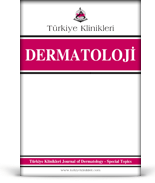Akne vulgaris, pilosebase birimi etkileyen kronik inflamatuar bir hastalıktır. Deri hastalıkları içinde sık yer alan akne, kişilerin %80'ini hayatlarının bir döneminde etkilemektedir. Olguların %60'ı kısa süreli ve hafif tedavilerle kontrol altına alınabilirken, %40'lık bölümde erişkin döneme kadar sebat edebilir. Akne oluşumu, kişinin dış görünüşünü etkilemesi ve skar bırakmasıyla beraber kişilerde depresyon, kaygı ve sosyal inhibisyon gibi psikolojik problemlerin de nedeni olabilmektedir. Bu çalışmada amaç, aknenin klinik şiddetinin yaşam kalitesiyle ilişkisini incelemektir. Gereç ve Yöntemler: Çalışmaya toplam 100 akne vulgaris tanısı konmuş hasta dâhil edildi. Hastaların yaşı, cinsiyeti, hastalık süreleri ve daha önce aldıkları lokal ve sistemik tedaviler ve akne şiddetleri kaydedildi. Akne yaşam kalite ölçeği (AcneQoL) uygulanarak toplam skorları saptandı. Bulgular: Akneli hastaların Acne-QoL'den aldıkları puanların ortalaması 16±5,22 olup hafif-orta ve şiddetli akne grubu arasında yaşam kalitesi açısından istatistiksel olarak anlamlı fark bulunmamıştır (p>0,05). Sonuç: Akne, fiziksel görünümü etkilemekle birlikte, hafif ve orta klinik tiplerde de hastaların yaşam kalitesini büyük oranda etkileyebilmektedir.
Anahtar Kelimeler: Akne; şiddetli akne; yaşam kalitesi
Objective: Acne vulgaris is a chronic inflammatory disease that affects the pilosebaceous unit. Acne, is a common skin disease, that affects 80% of the population at some point in their lives. While 60% of the cases may be controlled with short-term and mild treatments, 40% may persist until the adulthood. Although acne formation affects the physical appearance of the person and leaves a scar, it may also be the cause of psychological problems such as depression, anxiety, and social inhibition. The aim of this study is to examine the relationship between the clinical severity of acne and quality of life. Material and Methods: A total of 100 patients diagnosed with acne vulgaris were included in the study. The patients' age, gender, duration of the disease, and local and systemic treatments that were received before and acne severity scores were recorded. Acne quality of life questionnaire (Acne-QoL) was applied and total scores were determined. Results: The average of the Acne-QoL scores was 16±5.22, and there was no statistically significant difference between the mild-moderate and severe acne groups in terms of quality of life (p>0.05). Conclusion: Although acne affects the physical appearance, it may also greatly affect the quality of life of patients in mild and moderate clinical types.
Keywords: Acne; severe acne; quality of life
- Kilkenny M, Merlin K, Young R, Marks R. The prevalence of common skin conditions in Australian school students: 1. common, plane and plantar viral warts. Br J Dermatol. 1998;138(5): 840-5. [Crossref] [PubMed]
- Zaenglain AL, Thiboutot DM. Acne vulgaris. In: Bolognia JL, Jorizzo JL, Schaffer JV, eds. Dermatology. 4th ed. Philadelphia, PA: Elsevier; 2018. p.545-60.
- Yazici K, Baz K, Yazici AE, Köktürk A, Tot S, Demirseren D, et al. Disease-spesific quality of life is associated with anxiety and depression in patients with acne. J Eur Acad Dermatol Venereol. 2004;18(4):435-9. [Crossref] [PubMed]
- Mosam A, Vawda NB, Gordhan AH, Nkwanyana N, Aboobaker J. Quality of life issues for South Africans with acne vulgaris. Clin Exp Dermatol. 2005;30(1):6-9. [Crossref] [PubMed]
- Gupta MA, Johnson AM, Gupta AK. The development of an acne quality of life scale: reliability, validity, and relation to subjective acne severity in mild to moderate acne vulgaris. Acta Dermatol Venereol. 1998;78(6):451-6. [Crossref] [PubMed]
- Demirçay Z, Şenol A, Seçkin D, Demir F. [Reliability of Turkish version of acne quality of life scale in patients with acne vulgaris]. Türkderm. 2006;40(3):94-7.
- Doshi A, Zaheer A, Stiller MJ. A comparison of current acne grading systems and proposal of a novel system. Int J Dermatol. 1997;36(6):416-8. [Crossref] [PubMed]
- Cunliffe WJ, Simpson NB. Disorders of the sebaceous glands. In: Burns T, Breathnach S, Cox N, Griffiths C, eds. Textbook of Dermatology. 7th ed. Chapt. 43. Masscashusetts: Blackwell Science; 2004. p.1-7.
- Knaggs HE, Wood EJ, Rizer RL, Mills OH. Post-adolescent acne. Int J Cosmet Sci. 2004;26(3):129-38. [Crossref] [PubMed]
- Aktan Ş, İnanır I, Şanlı B, Uz N. Acne prevalence in high school students:an epidemiological study. TURKDERM. 1999;33(1):37-9.
- Türel Ermertcan A. [Acne and quality of life]. Dermatoz. 2007;2:91-7.
- Golchai J, Khani SH, Heidarzadeh A, Eshkevari SS, Alizade N, Eftekhari H, et al. Comparison of anxiety and depression in patients with acne vulgaris and healty individuals. Indian J Dermatol. 2010;55(4):352-4. [Crossref] [PubMed] [PMC]
- Cyrulnik AA, Viola KV, Gewirtzman AJ, Cohen SR. High-dose isotretinoin in acne vulgaris: improved treatment outcomes and quality of life. Int J Dermatol. 2012;51(9):1123-30. [Crossref] [PubMed]
- Yarpuz AY, Saadet ED, Sanli HE, Ozguven HD. [Social anxiety level in acne vulgaris patients and its relationship to clinical variables]. Turk Psikiyatri Derg. 2008;19(1):29-37. [PubMed]
- Öztürkcan S, Aydemir Ö, İnanır I. [Life quality in patients with acne vulgaris). T Klin J Dermatol. 2002;12(3):131-4.
- Jones-Caballero M, Chren MM, Soler B, Pedrosa E, Pe-as PF. Quality of life in mild to moderate acne: relationship to clinical severity and factors influencing change with treatment. J Eur Acad Dermatol Venereol. 2007;21(2):219-26. [Crossref] [PubMed]
- Gupta MA, Gupta AK. Psychiatric and psychological co-morbidity in patients with dermatologic disorders: epidemiology and management. Am J Clin Dermatol. 2003;4(12):833-42. [Crossref] [PubMed]
- Salek MS, Khan GK, Finlay AY. Questionnaires techniques in assessing acne handicap: reliability and validity study. Qual Life Res. 1996;5(1):131-8. [Crossref] [PubMed]
- Rehn LMH, Meririnne E, Höök-Nikanne J, Isometsä E, Henriksson M. Depressive symptoms, suicidal idention and acne: a study of male finnish conscripts. J Eur Acad Dermatol Venerol. 2008;22(5):561-7. [Crossref] [PubMed]
- Ertam I, Aytimur D. There is no correlation between acne severity and AQOLS/DLQI scores. J Dermatol. 2005;32(9):705-10. [Crossref] [PubMed]
- Abdel-Hafez K, Mahran AM, Hofny ERM, Mohammed KA, Darweesh AM, Aal AA, et al. The impact of acne vulgaris on the quality of life and psychologic status in patient from upper Egypt. Int J Dermatol. 2009;48(3):280-5. [Crossref] [PubMed]
- Hanisah A, Omar K, Shah SA. Prevalence of acne and it's impact on the quality of life in school-aged adolescents in Malaysia. J Prim Health Care. 2009;1(1):20-5. [Crossref] [PubMed]







.: İşlem Listesi